Marketing in an International Environment
VerifiedAdded on 2023/06/11
|17
|4613
|104
AI Summary
This report discusses Uniqlo's marketing plan to penetrate the Indian market. It includes a comprehensive literature review on SWOT analysis, product, segmentation and position strategy, pricing, distribution, and promotion strategies. The report also covers problem identification, solutions, future management control, and measurement systems. The report concludes with recommendations and references.
Contribute Materials
Your contribution can guide someone’s learning journey. Share your
documents today.
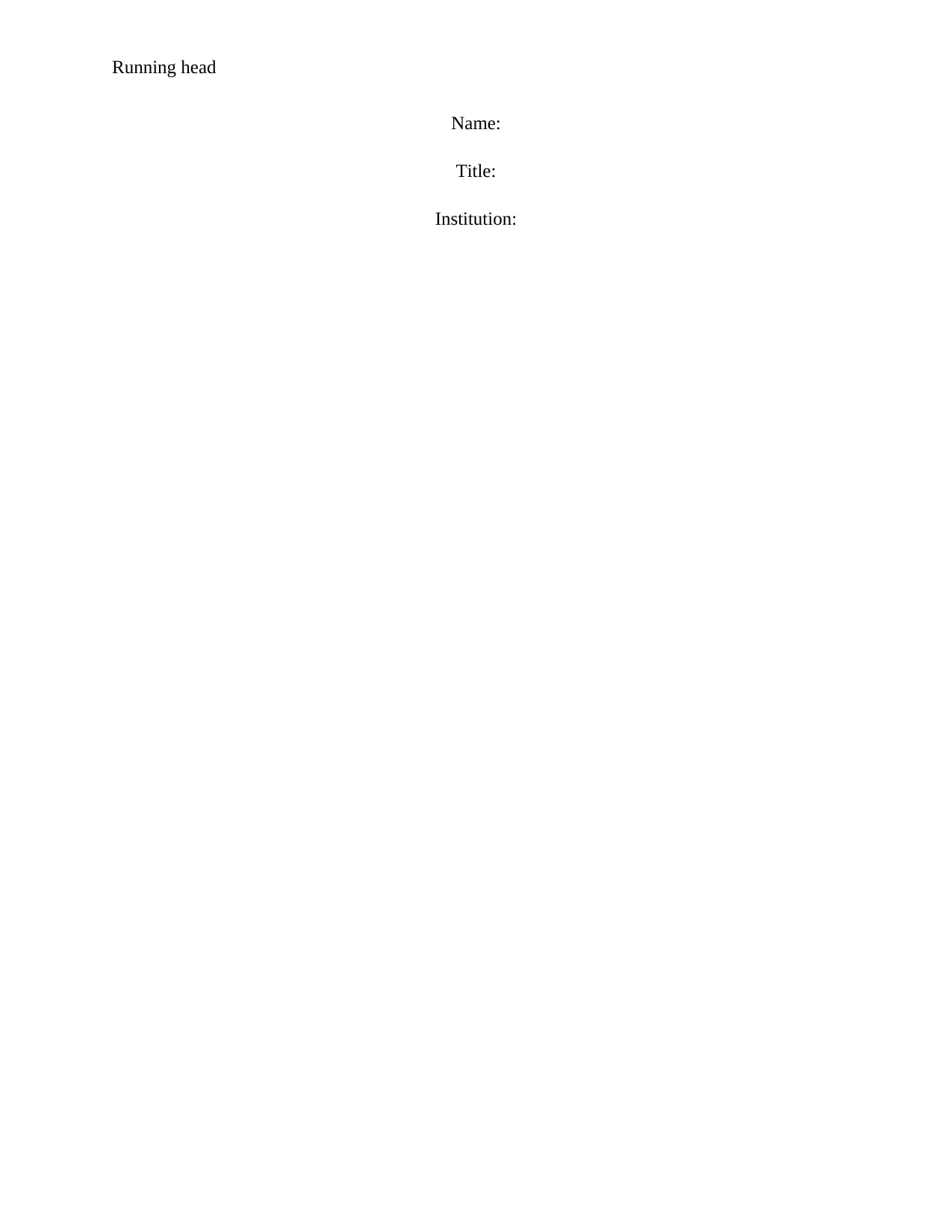
Running head
Name:
Title:
Institution:
Name:
Title:
Institution:
Secure Best Marks with AI Grader
Need help grading? Try our AI Grader for instant feedback on your assignments.
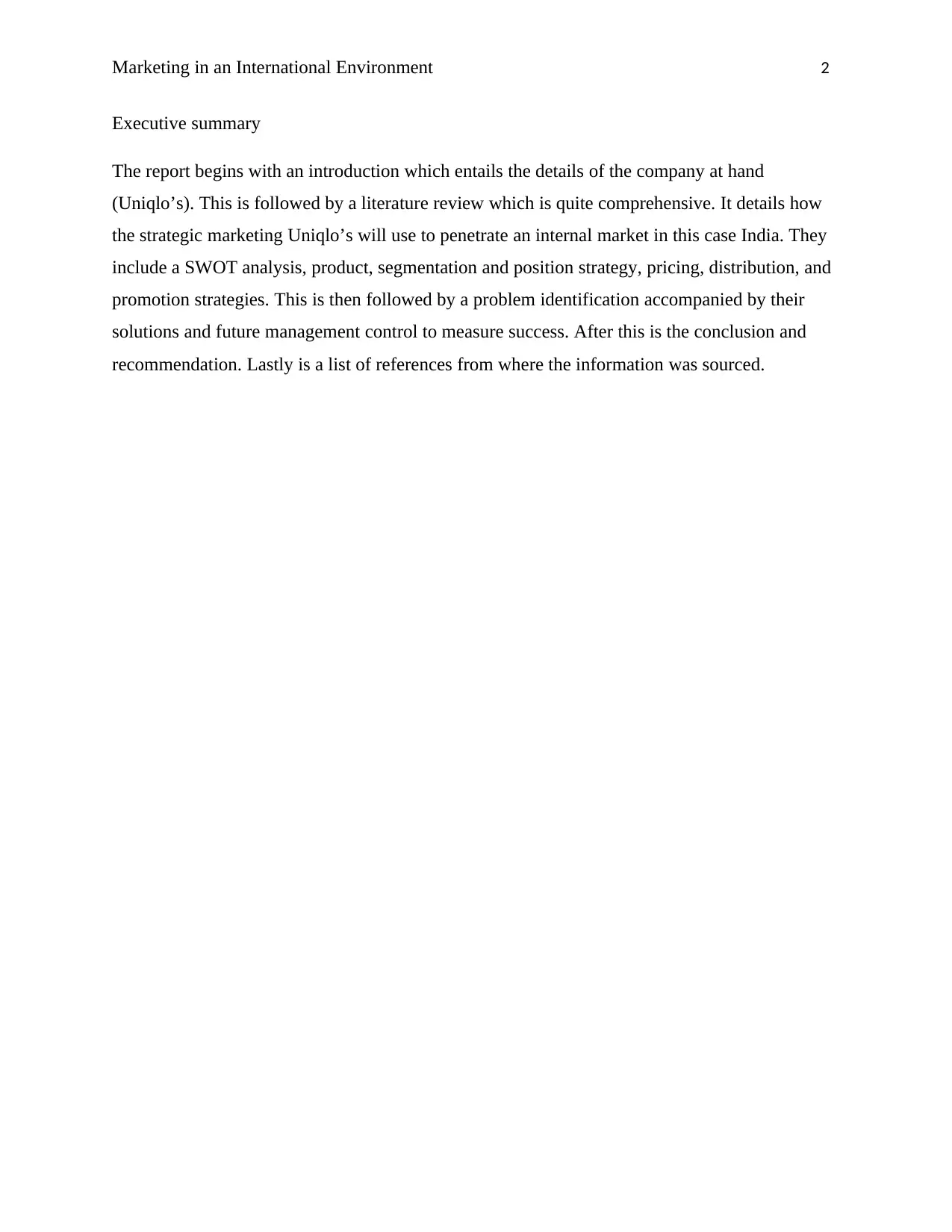
Marketing in an International Environment 2
Executive summary
The report begins with an introduction which entails the details of the company at hand
(Uniqlo’s). This is followed by a literature review which is quite comprehensive. It details how
the strategic marketing Uniqlo’s will use to penetrate an internal market in this case India. They
include a SWOT analysis, product, segmentation and position strategy, pricing, distribution, and
promotion strategies. This is then followed by a problem identification accompanied by their
solutions and future management control to measure success. After this is the conclusion and
recommendation. Lastly is a list of references from where the information was sourced.
Executive summary
The report begins with an introduction which entails the details of the company at hand
(Uniqlo’s). This is followed by a literature review which is quite comprehensive. It details how
the strategic marketing Uniqlo’s will use to penetrate an internal market in this case India. They
include a SWOT analysis, product, segmentation and position strategy, pricing, distribution, and
promotion strategies. This is then followed by a problem identification accompanied by their
solutions and future management control to measure success. After this is the conclusion and
recommendation. Lastly is a list of references from where the information was sourced.
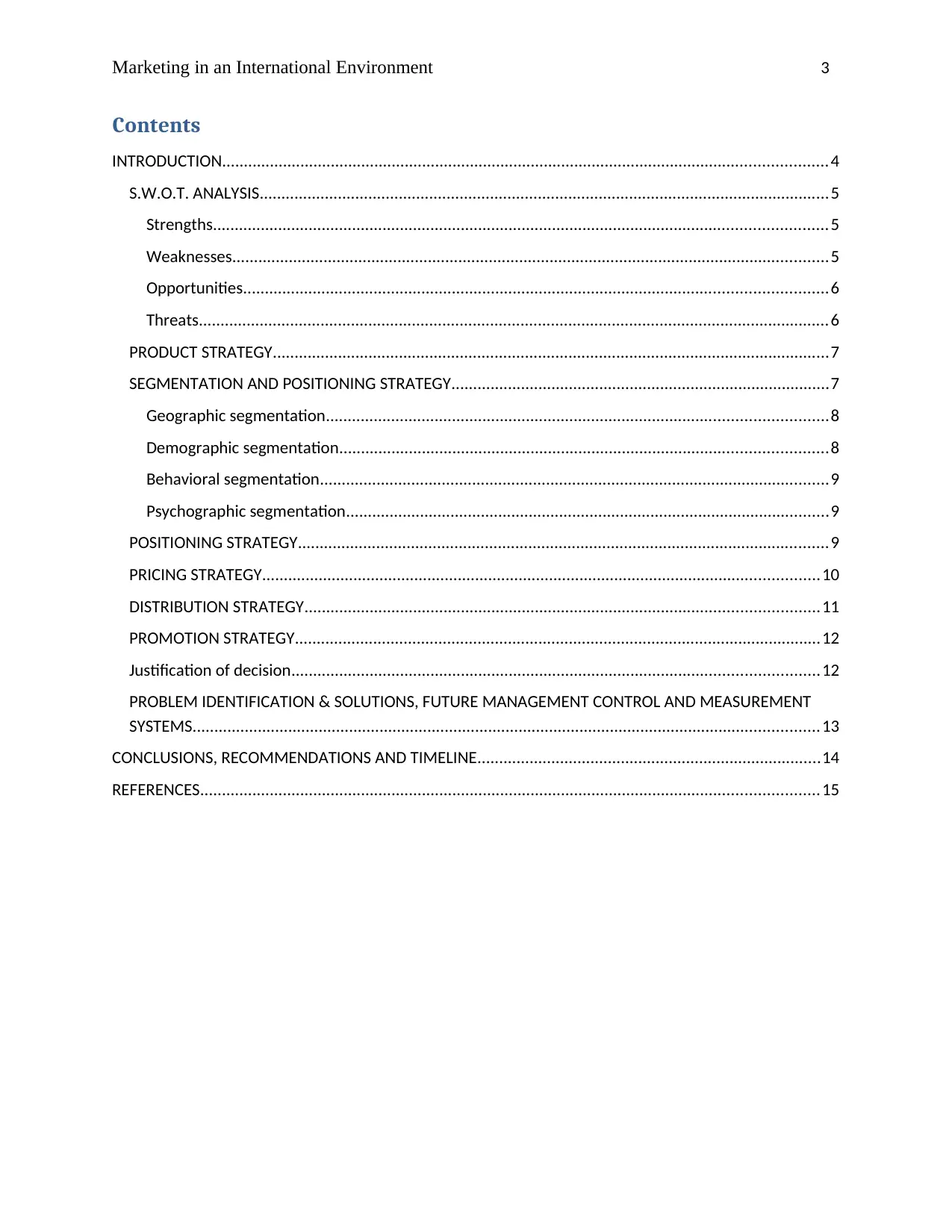
Marketing in an International Environment 3
Contents
INTRODUCTION...........................................................................................................................................4
S.W.O.T. ANALYSIS...................................................................................................................................5
Strengths.............................................................................................................................................5
Weaknesses.........................................................................................................................................5
Opportunities......................................................................................................................................6
Threats.................................................................................................................................................6
PRODUCT STRATEGY................................................................................................................................7
SEGMENTATION AND POSITIONING STRATEGY.......................................................................................7
Geographic segmentation...................................................................................................................8
Demographic segmentation................................................................................................................8
Behavioral segmentation.....................................................................................................................9
Psychographic segmentation...............................................................................................................9
POSITIONING STRATEGY..........................................................................................................................9
PRICING STRATEGY................................................................................................................................10
DISTRIBUTION STRATEGY......................................................................................................................11
PROMOTION STRATEGY.........................................................................................................................12
Justification of decision.........................................................................................................................12
PROBLEM IDENTIFICATION & SOLUTIONS, FUTURE MANAGEMENT CONTROL AND MEASUREMENT
SYSTEMS................................................................................................................................................13
CONCLUSIONS, RECOMMENDATIONS AND TIMELINE...............................................................................14
REFERENCES..............................................................................................................................................15
Contents
INTRODUCTION...........................................................................................................................................4
S.W.O.T. ANALYSIS...................................................................................................................................5
Strengths.............................................................................................................................................5
Weaknesses.........................................................................................................................................5
Opportunities......................................................................................................................................6
Threats.................................................................................................................................................6
PRODUCT STRATEGY................................................................................................................................7
SEGMENTATION AND POSITIONING STRATEGY.......................................................................................7
Geographic segmentation...................................................................................................................8
Demographic segmentation................................................................................................................8
Behavioral segmentation.....................................................................................................................9
Psychographic segmentation...............................................................................................................9
POSITIONING STRATEGY..........................................................................................................................9
PRICING STRATEGY................................................................................................................................10
DISTRIBUTION STRATEGY......................................................................................................................11
PROMOTION STRATEGY.........................................................................................................................12
Justification of decision.........................................................................................................................12
PROBLEM IDENTIFICATION & SOLUTIONS, FUTURE MANAGEMENT CONTROL AND MEASUREMENT
SYSTEMS................................................................................................................................................13
CONCLUSIONS, RECOMMENDATIONS AND TIMELINE...............................................................................14
REFERENCES..............................................................................................................................................15
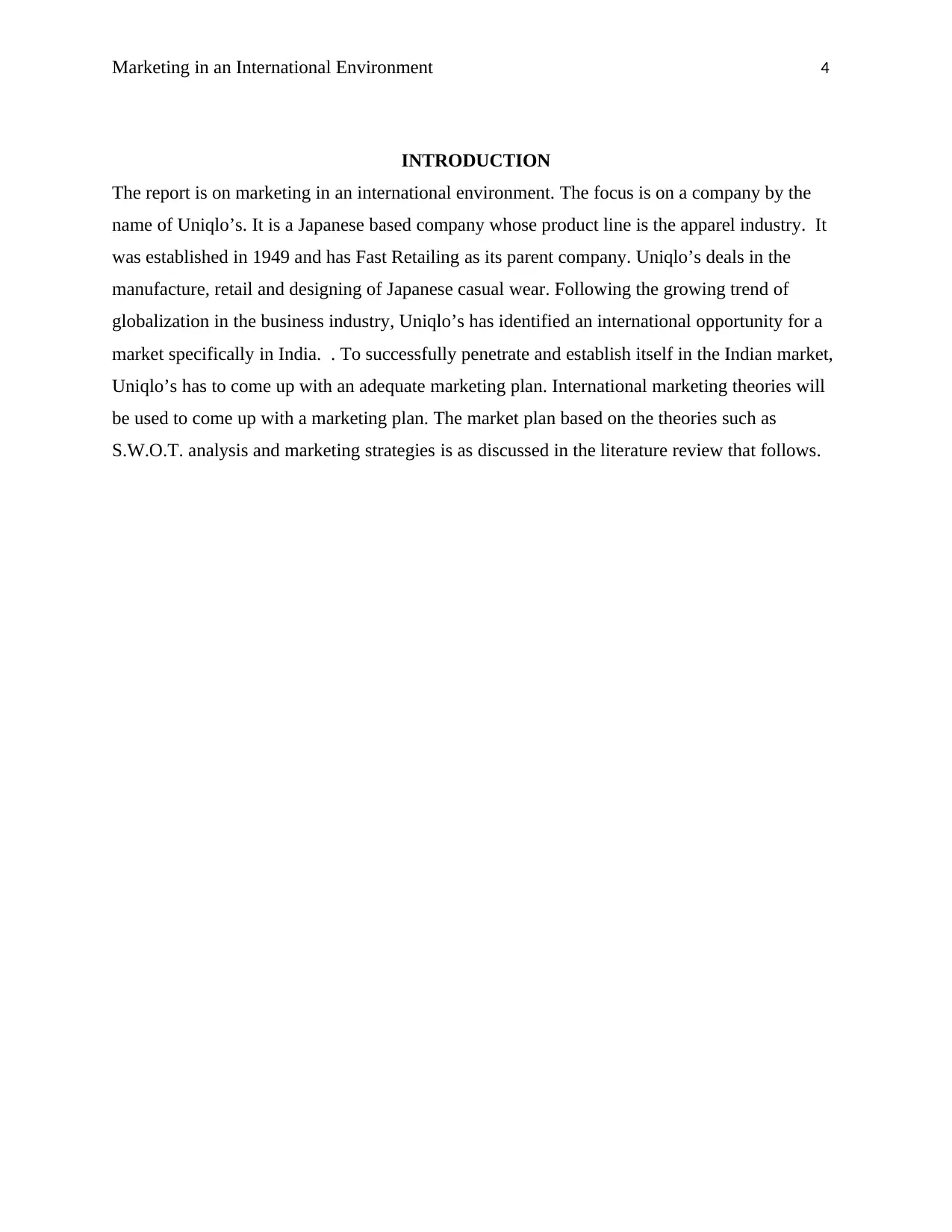
Marketing in an International Environment 4
INTRODUCTION
The report is on marketing in an international environment. The focus is on a company by the
name of Uniqlo’s. It is a Japanese based company whose product line is the apparel industry. It
was established in 1949 and has Fast Retailing as its parent company. Uniqlo’s deals in the
manufacture, retail and designing of Japanese casual wear. Following the growing trend of
globalization in the business industry, Uniqlo’s has identified an international opportunity for a
market specifically in India. . To successfully penetrate and establish itself in the Indian market,
Uniqlo’s has to come up with an adequate marketing plan. International marketing theories will
be used to come up with a marketing plan. The market plan based on the theories such as
S.W.O.T. analysis and marketing strategies is as discussed in the literature review that follows.
INTRODUCTION
The report is on marketing in an international environment. The focus is on a company by the
name of Uniqlo’s. It is a Japanese based company whose product line is the apparel industry. It
was established in 1949 and has Fast Retailing as its parent company. Uniqlo’s deals in the
manufacture, retail and designing of Japanese casual wear. Following the growing trend of
globalization in the business industry, Uniqlo’s has identified an international opportunity for a
market specifically in India. . To successfully penetrate and establish itself in the Indian market,
Uniqlo’s has to come up with an adequate marketing plan. International marketing theories will
be used to come up with a marketing plan. The market plan based on the theories such as
S.W.O.T. analysis and marketing strategies is as discussed in the literature review that follows.
Secure Best Marks with AI Grader
Need help grading? Try our AI Grader for instant feedback on your assignments.
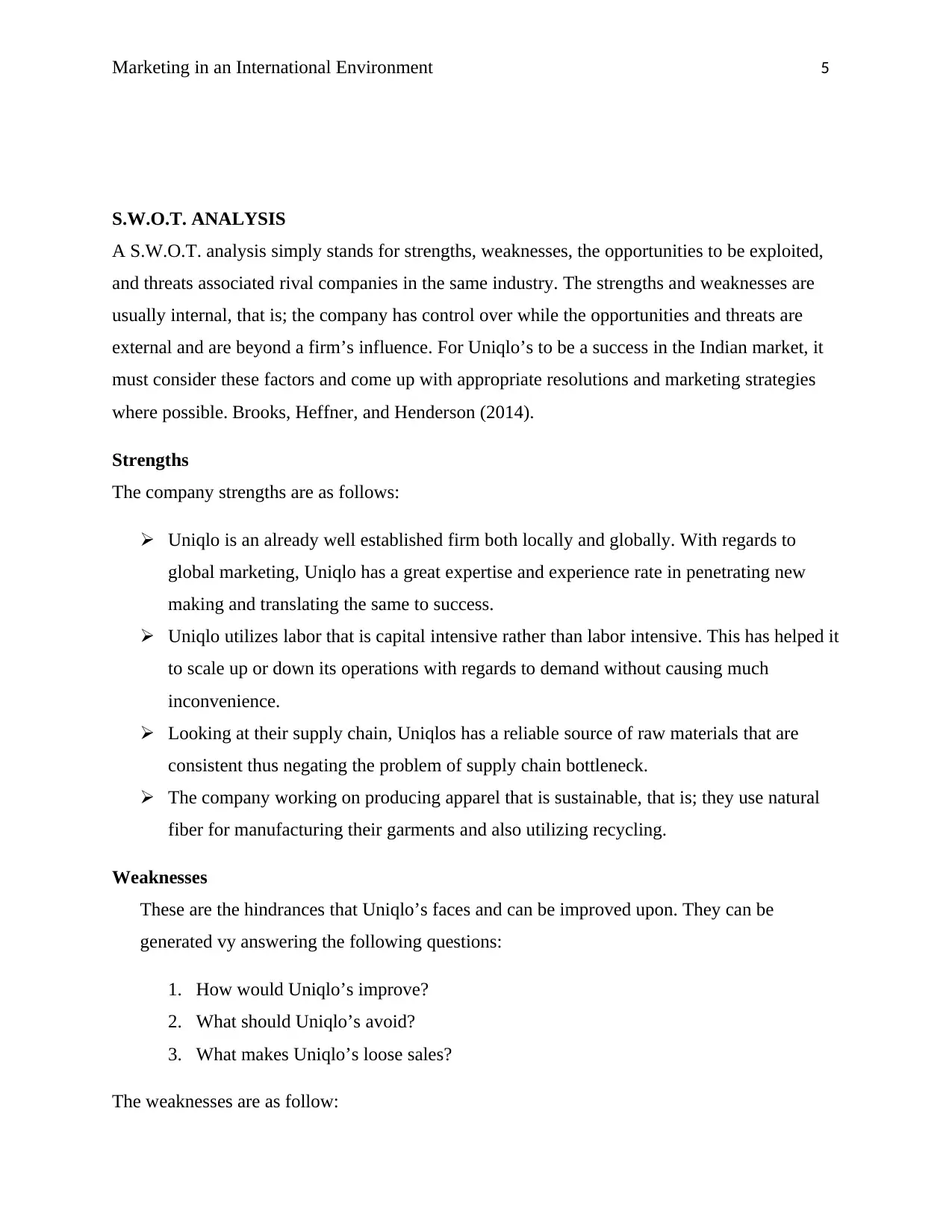
Marketing in an International Environment 5
S.W.O.T. ANALYSIS
A S.W.O.T. analysis simply stands for strengths, weaknesses, the opportunities to be exploited,
and threats associated rival companies in the same industry. The strengths and weaknesses are
usually internal, that is; the company has control over while the opportunities and threats are
external and are beyond a firm’s influence. For Uniqlo’s to be a success in the Indian market, it
must consider these factors and come up with appropriate resolutions and marketing strategies
where possible. Brooks, Heffner, and Henderson (2014).
Strengths
The company strengths are as follows:
Uniqlo is an already well established firm both locally and globally. With regards to
global marketing, Uniqlo has a great expertise and experience rate in penetrating new
making and translating the same to success.
Uniqlo utilizes labor that is capital intensive rather than labor intensive. This has helped it
to scale up or down its operations with regards to demand without causing much
inconvenience.
Looking at their supply chain, Uniqlos has a reliable source of raw materials that are
consistent thus negating the problem of supply chain bottleneck.
The company working on producing apparel that is sustainable, that is; they use natural
fiber for manufacturing their garments and also utilizing recycling.
Weaknesses
These are the hindrances that Uniqlo’s faces and can be improved upon. They can be
generated vy answering the following questions:
1. How would Uniqlo’s improve?
2. What should Uniqlo’s avoid?
3. What makes Uniqlo’s loose sales?
The weaknesses are as follow:
S.W.O.T. ANALYSIS
A S.W.O.T. analysis simply stands for strengths, weaknesses, the opportunities to be exploited,
and threats associated rival companies in the same industry. The strengths and weaknesses are
usually internal, that is; the company has control over while the opportunities and threats are
external and are beyond a firm’s influence. For Uniqlo’s to be a success in the Indian market, it
must consider these factors and come up with appropriate resolutions and marketing strategies
where possible. Brooks, Heffner, and Henderson (2014).
Strengths
The company strengths are as follows:
Uniqlo is an already well established firm both locally and globally. With regards to
global marketing, Uniqlo has a great expertise and experience rate in penetrating new
making and translating the same to success.
Uniqlo utilizes labor that is capital intensive rather than labor intensive. This has helped it
to scale up or down its operations with regards to demand without causing much
inconvenience.
Looking at their supply chain, Uniqlos has a reliable source of raw materials that are
consistent thus negating the problem of supply chain bottleneck.
The company working on producing apparel that is sustainable, that is; they use natural
fiber for manufacturing their garments and also utilizing recycling.
Weaknesses
These are the hindrances that Uniqlo’s faces and can be improved upon. They can be
generated vy answering the following questions:
1. How would Uniqlo’s improve?
2. What should Uniqlo’s avoid?
3. What makes Uniqlo’s loose sales?
The weaknesses are as follow:
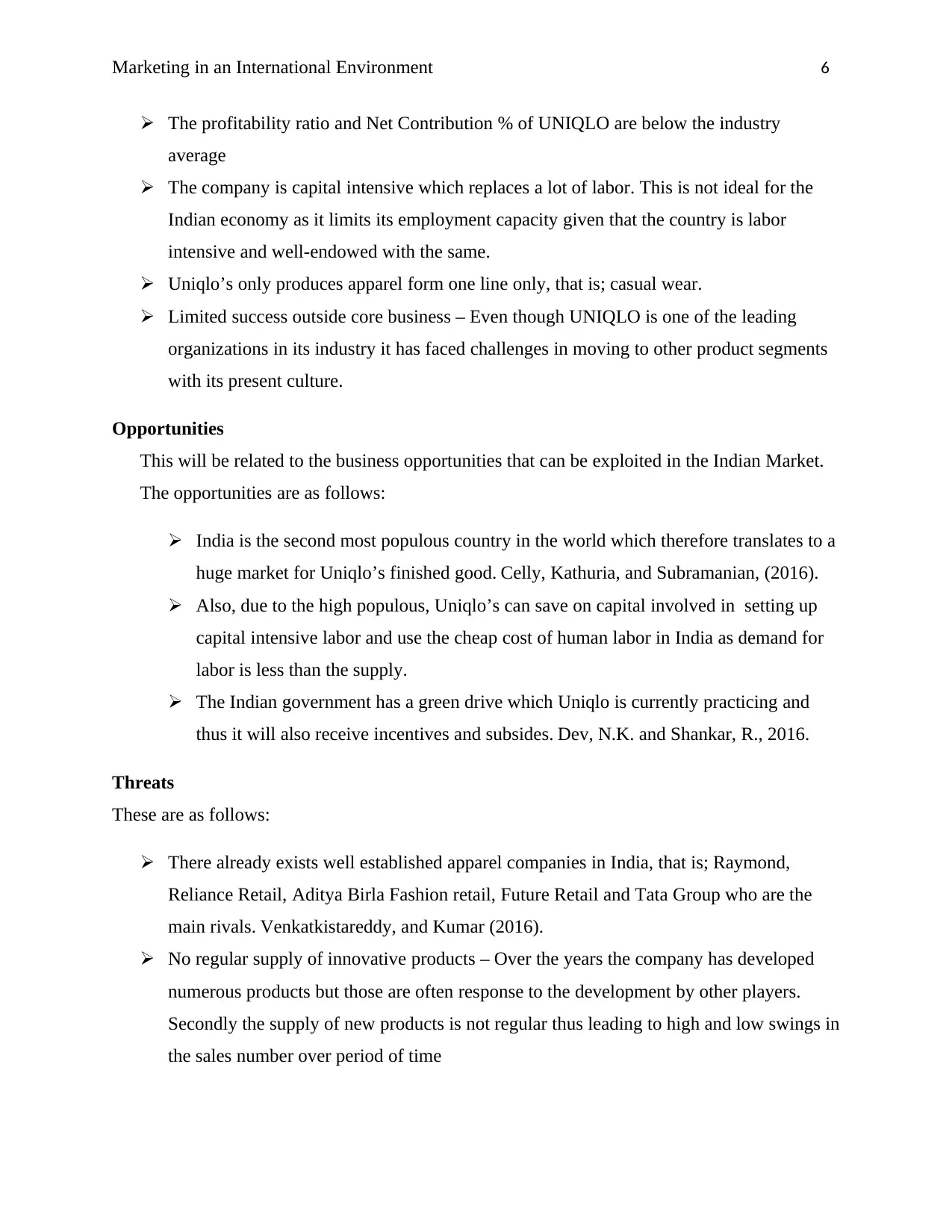
Marketing in an International Environment 6
The profitability ratio and Net Contribution % of UNIQLO are below the industry
average
The company is capital intensive which replaces a lot of labor. This is not ideal for the
Indian economy as it limits its employment capacity given that the country is labor
intensive and well-endowed with the same.
Uniqlo’s only produces apparel form one line only, that is; casual wear.
Limited success outside core business – Even though UNIQLO is one of the leading
organizations in its industry it has faced challenges in moving to other product segments
with its present culture.
Opportunities
This will be related to the business opportunities that can be exploited in the Indian Market.
The opportunities are as follows:
India is the second most populous country in the world which therefore translates to a
huge market for Uniqlo’s finished good. Celly, Kathuria, and Subramanian, (2016).
Also, due to the high populous, Uniqlo’s can save on capital involved in setting up
capital intensive labor and use the cheap cost of human labor in India as demand for
labor is less than the supply.
The Indian government has a green drive which Uniqlo is currently practicing and
thus it will also receive incentives and subsides. Dev, N.K. and Shankar, R., 2016.
Threats
These are as follows:
There already exists well established apparel companies in India, that is; Raymond,
Reliance Retail, Aditya Birla Fashion retail, Future Retail and Tata Group who are the
main rivals. Venkatkistareddy, and Kumar (2016).
No regular supply of innovative products – Over the years the company has developed
numerous products but those are often response to the development by other players.
Secondly the supply of new products is not regular thus leading to high and low swings in
the sales number over period of time
The profitability ratio and Net Contribution % of UNIQLO are below the industry
average
The company is capital intensive which replaces a lot of labor. This is not ideal for the
Indian economy as it limits its employment capacity given that the country is labor
intensive and well-endowed with the same.
Uniqlo’s only produces apparel form one line only, that is; casual wear.
Limited success outside core business – Even though UNIQLO is one of the leading
organizations in its industry it has faced challenges in moving to other product segments
with its present culture.
Opportunities
This will be related to the business opportunities that can be exploited in the Indian Market.
The opportunities are as follows:
India is the second most populous country in the world which therefore translates to a
huge market for Uniqlo’s finished good. Celly, Kathuria, and Subramanian, (2016).
Also, due to the high populous, Uniqlo’s can save on capital involved in setting up
capital intensive labor and use the cheap cost of human labor in India as demand for
labor is less than the supply.
The Indian government has a green drive which Uniqlo is currently practicing and
thus it will also receive incentives and subsides. Dev, N.K. and Shankar, R., 2016.
Threats
These are as follows:
There already exists well established apparel companies in India, that is; Raymond,
Reliance Retail, Aditya Birla Fashion retail, Future Retail and Tata Group who are the
main rivals. Venkatkistareddy, and Kumar (2016).
No regular supply of innovative products – Over the years the company has developed
numerous products but those are often response to the development by other players.
Secondly the supply of new products is not regular thus leading to high and low swings in
the sales number over period of time
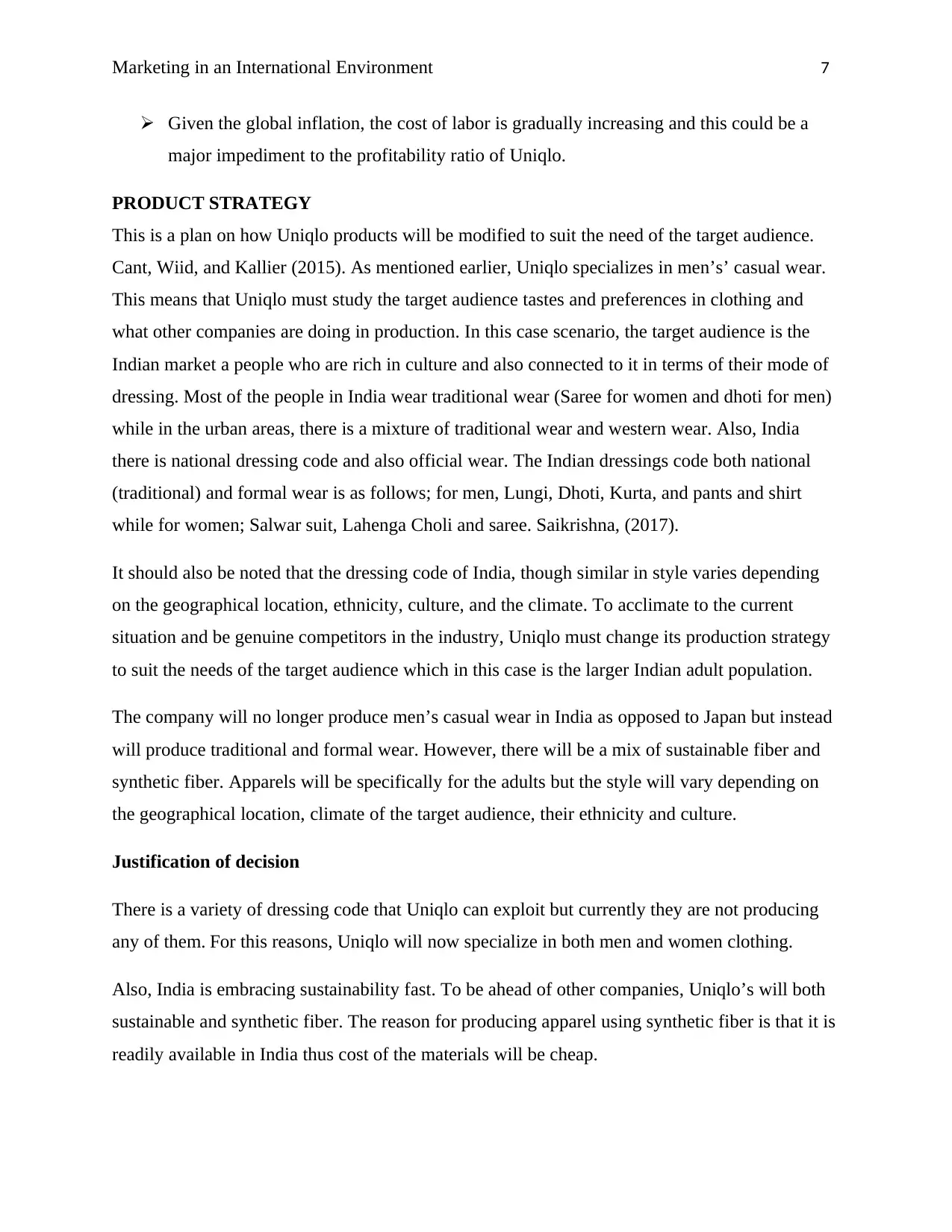
Marketing in an International Environment 7
Given the global inflation, the cost of labor is gradually increasing and this could be a
major impediment to the profitability ratio of Uniqlo.
PRODUCT STRATEGY
This is a plan on how Uniqlo products will be modified to suit the need of the target audience.
Cant, Wiid, and Kallier (2015). As mentioned earlier, Uniqlo specializes in men’s’ casual wear.
This means that Uniqlo must study the target audience tastes and preferences in clothing and
what other companies are doing in production. In this case scenario, the target audience is the
Indian market a people who are rich in culture and also connected to it in terms of their mode of
dressing. Most of the people in India wear traditional wear (Saree for women and dhoti for men)
while in the urban areas, there is a mixture of traditional wear and western wear. Also, India
there is national dressing code and also official wear. The Indian dressings code both national
(traditional) and formal wear is as follows; for men, Lungi, Dhoti, Kurta, and pants and shirt
while for women; Salwar suit, Lahenga Choli and saree. Saikrishna, (2017).
It should also be noted that the dressing code of India, though similar in style varies depending
on the geographical location, ethnicity, culture, and the climate. To acclimate to the current
situation and be genuine competitors in the industry, Uniqlo must change its production strategy
to suit the needs of the target audience which in this case is the larger Indian adult population.
The company will no longer produce men’s casual wear in India as opposed to Japan but instead
will produce traditional and formal wear. However, there will be a mix of sustainable fiber and
synthetic fiber. Apparels will be specifically for the adults but the style will vary depending on
the geographical location, climate of the target audience, their ethnicity and culture.
Justification of decision
There is a variety of dressing code that Uniqlo can exploit but currently they are not producing
any of them. For this reasons, Uniqlo will now specialize in both men and women clothing.
Also, India is embracing sustainability fast. To be ahead of other companies, Uniqlo’s will both
sustainable and synthetic fiber. The reason for producing apparel using synthetic fiber is that it is
readily available in India thus cost of the materials will be cheap.
Given the global inflation, the cost of labor is gradually increasing and this could be a
major impediment to the profitability ratio of Uniqlo.
PRODUCT STRATEGY
This is a plan on how Uniqlo products will be modified to suit the need of the target audience.
Cant, Wiid, and Kallier (2015). As mentioned earlier, Uniqlo specializes in men’s’ casual wear.
This means that Uniqlo must study the target audience tastes and preferences in clothing and
what other companies are doing in production. In this case scenario, the target audience is the
Indian market a people who are rich in culture and also connected to it in terms of their mode of
dressing. Most of the people in India wear traditional wear (Saree for women and dhoti for men)
while in the urban areas, there is a mixture of traditional wear and western wear. Also, India
there is national dressing code and also official wear. The Indian dressings code both national
(traditional) and formal wear is as follows; for men, Lungi, Dhoti, Kurta, and pants and shirt
while for women; Salwar suit, Lahenga Choli and saree. Saikrishna, (2017).
It should also be noted that the dressing code of India, though similar in style varies depending
on the geographical location, ethnicity, culture, and the climate. To acclimate to the current
situation and be genuine competitors in the industry, Uniqlo must change its production strategy
to suit the needs of the target audience which in this case is the larger Indian adult population.
The company will no longer produce men’s casual wear in India as opposed to Japan but instead
will produce traditional and formal wear. However, there will be a mix of sustainable fiber and
synthetic fiber. Apparels will be specifically for the adults but the style will vary depending on
the geographical location, climate of the target audience, their ethnicity and culture.
Justification of decision
There is a variety of dressing code that Uniqlo can exploit but currently they are not producing
any of them. For this reasons, Uniqlo will now specialize in both men and women clothing.
Also, India is embracing sustainability fast. To be ahead of other companies, Uniqlo’s will both
sustainable and synthetic fiber. The reason for producing apparel using synthetic fiber is that it is
readily available in India thus cost of the materials will be cheap.
Paraphrase This Document
Need a fresh take? Get an instant paraphrase of this document with our AI Paraphraser
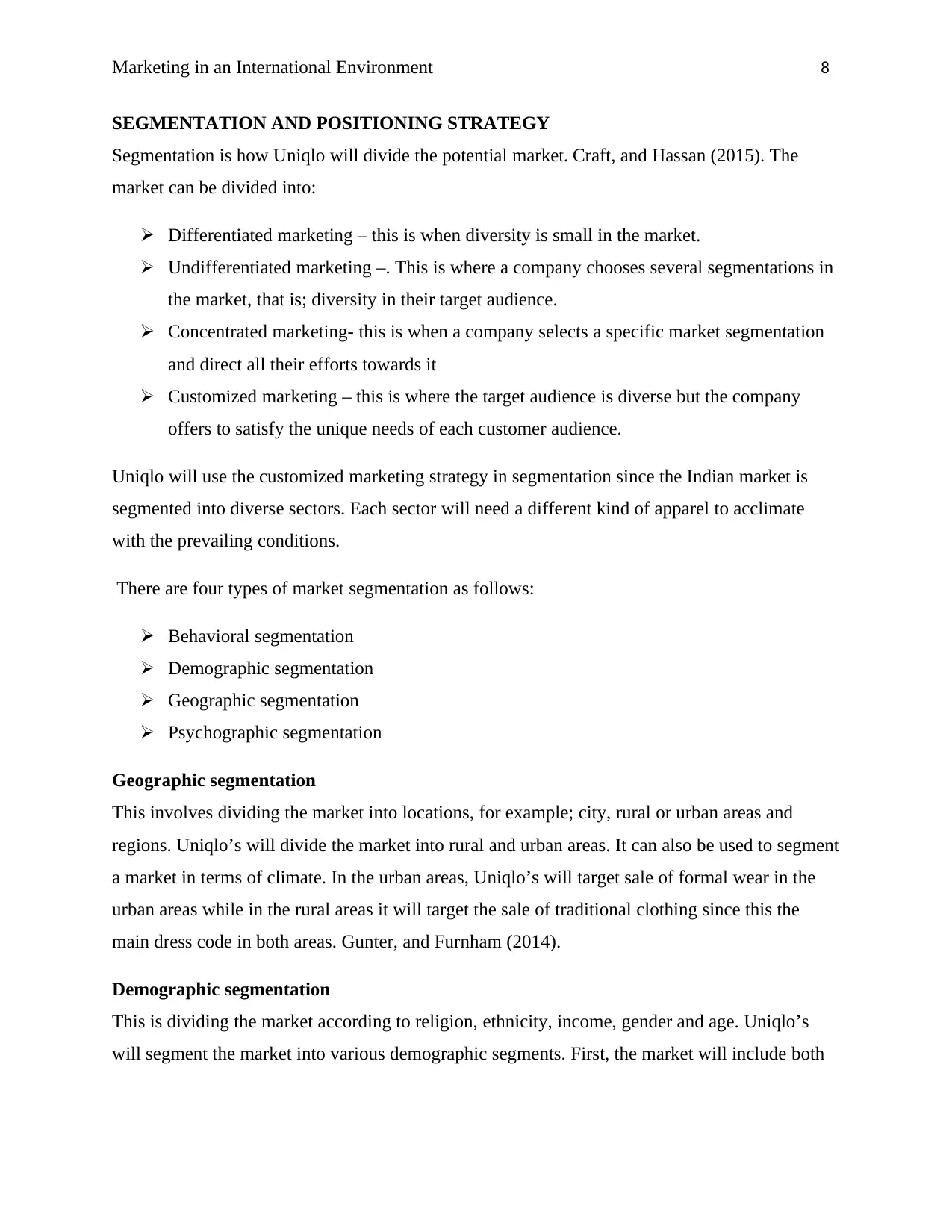
Marketing in an International Environment 8
SEGMENTATION AND POSITIONING STRATEGY
Segmentation is how Uniqlo will divide the potential market. Craft, and Hassan (2015). The
market can be divided into:
Differentiated marketing – this is when diversity is small in the market.
Undifferentiated marketing –. This is where a company chooses several segmentations in
the market, that is; diversity in their target audience.
Concentrated marketing- this is when a company selects a specific market segmentation
and direct all their efforts towards it
Customized marketing – this is where the target audience is diverse but the company
offers to satisfy the unique needs of each customer audience.
Uniqlo will use the customized marketing strategy in segmentation since the Indian market is
segmented into diverse sectors. Each sector will need a different kind of apparel to acclimate
with the prevailing conditions.
There are four types of market segmentation as follows:
Behavioral segmentation
Demographic segmentation
Geographic segmentation
Psychographic segmentation
Geographic segmentation
This involves dividing the market into locations, for example; city, rural or urban areas and
regions. Uniqlo’s will divide the market into rural and urban areas. It can also be used to segment
a market in terms of climate. In the urban areas, Uniqlo’s will target sale of formal wear in the
urban areas while in the rural areas it will target the sale of traditional clothing since this the
main dress code in both areas. Gunter, and Furnham (2014).
Demographic segmentation
This is dividing the market according to religion, ethnicity, income, gender and age. Uniqlo’s
will segment the market into various demographic segments. First, the market will include both
SEGMENTATION AND POSITIONING STRATEGY
Segmentation is how Uniqlo will divide the potential market. Craft, and Hassan (2015). The
market can be divided into:
Differentiated marketing – this is when diversity is small in the market.
Undifferentiated marketing –. This is where a company chooses several segmentations in
the market, that is; diversity in their target audience.
Concentrated marketing- this is when a company selects a specific market segmentation
and direct all their efforts towards it
Customized marketing – this is where the target audience is diverse but the company
offers to satisfy the unique needs of each customer audience.
Uniqlo will use the customized marketing strategy in segmentation since the Indian market is
segmented into diverse sectors. Each sector will need a different kind of apparel to acclimate
with the prevailing conditions.
There are four types of market segmentation as follows:
Behavioral segmentation
Demographic segmentation
Geographic segmentation
Psychographic segmentation
Geographic segmentation
This involves dividing the market into locations, for example; city, rural or urban areas and
regions. Uniqlo’s will divide the market into rural and urban areas. It can also be used to segment
a market in terms of climate. In the urban areas, Uniqlo’s will target sale of formal wear in the
urban areas while in the rural areas it will target the sale of traditional clothing since this the
main dress code in both areas. Gunter, and Furnham (2014).
Demographic segmentation
This is dividing the market according to religion, ethnicity, income, gender and age. Uniqlo’s
will segment the market into various demographic segments. First, the market will include both
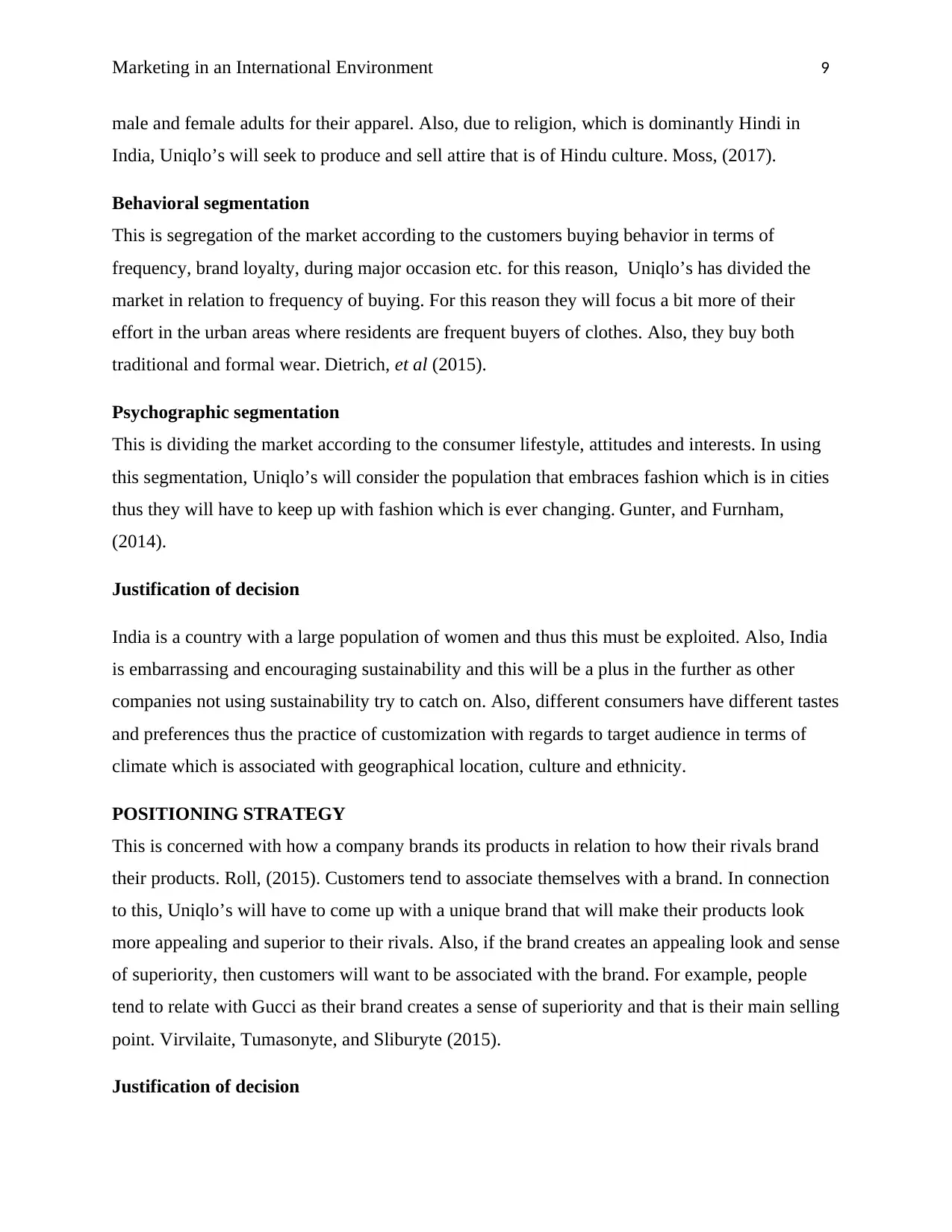
Marketing in an International Environment 9
male and female adults for their apparel. Also, due to religion, which is dominantly Hindi in
India, Uniqlo’s will seek to produce and sell attire that is of Hindu culture. Moss, (2017).
Behavioral segmentation
This is segregation of the market according to the customers buying behavior in terms of
frequency, brand loyalty, during major occasion etc. for this reason, Uniqlo’s has divided the
market in relation to frequency of buying. For this reason they will focus a bit more of their
effort in the urban areas where residents are frequent buyers of clothes. Also, they buy both
traditional and formal wear. Dietrich, et al (2015).
Psychographic segmentation
This is dividing the market according to the consumer lifestyle, attitudes and interests. In using
this segmentation, Uniqlo’s will consider the population that embraces fashion which is in cities
thus they will have to keep up with fashion which is ever changing. Gunter, and Furnham,
(2014).
Justification of decision
India is a country with a large population of women and thus this must be exploited. Also, India
is embarrassing and encouraging sustainability and this will be a plus in the further as other
companies not using sustainability try to catch on. Also, different consumers have different tastes
and preferences thus the practice of customization with regards to target audience in terms of
climate which is associated with geographical location, culture and ethnicity.
POSITIONING STRATEGY
This is concerned with how a company brands its products in relation to how their rivals brand
their products. Roll, (2015). Customers tend to associate themselves with a brand. In connection
to this, Uniqlo’s will have to come up with a unique brand that will make their products look
more appealing and superior to their rivals. Also, if the brand creates an appealing look and sense
of superiority, then customers will want to be associated with the brand. For example, people
tend to relate with Gucci as their brand creates a sense of superiority and that is their main selling
point. Virvilaite, Tumasonyte, and Sliburyte (2015).
Justification of decision
male and female adults for their apparel. Also, due to religion, which is dominantly Hindi in
India, Uniqlo’s will seek to produce and sell attire that is of Hindu culture. Moss, (2017).
Behavioral segmentation
This is segregation of the market according to the customers buying behavior in terms of
frequency, brand loyalty, during major occasion etc. for this reason, Uniqlo’s has divided the
market in relation to frequency of buying. For this reason they will focus a bit more of their
effort in the urban areas where residents are frequent buyers of clothes. Also, they buy both
traditional and formal wear. Dietrich, et al (2015).
Psychographic segmentation
This is dividing the market according to the consumer lifestyle, attitudes and interests. In using
this segmentation, Uniqlo’s will consider the population that embraces fashion which is in cities
thus they will have to keep up with fashion which is ever changing. Gunter, and Furnham,
(2014).
Justification of decision
India is a country with a large population of women and thus this must be exploited. Also, India
is embarrassing and encouraging sustainability and this will be a plus in the further as other
companies not using sustainability try to catch on. Also, different consumers have different tastes
and preferences thus the practice of customization with regards to target audience in terms of
climate which is associated with geographical location, culture and ethnicity.
POSITIONING STRATEGY
This is concerned with how a company brands its products in relation to how their rivals brand
their products. Roll, (2015). Customers tend to associate themselves with a brand. In connection
to this, Uniqlo’s will have to come up with a unique brand that will make their products look
more appealing and superior to their rivals. Also, if the brand creates an appealing look and sense
of superiority, then customers will want to be associated with the brand. For example, people
tend to relate with Gucci as their brand creates a sense of superiority and that is their main selling
point. Virvilaite, Tumasonyte, and Sliburyte (2015).
Justification of decision
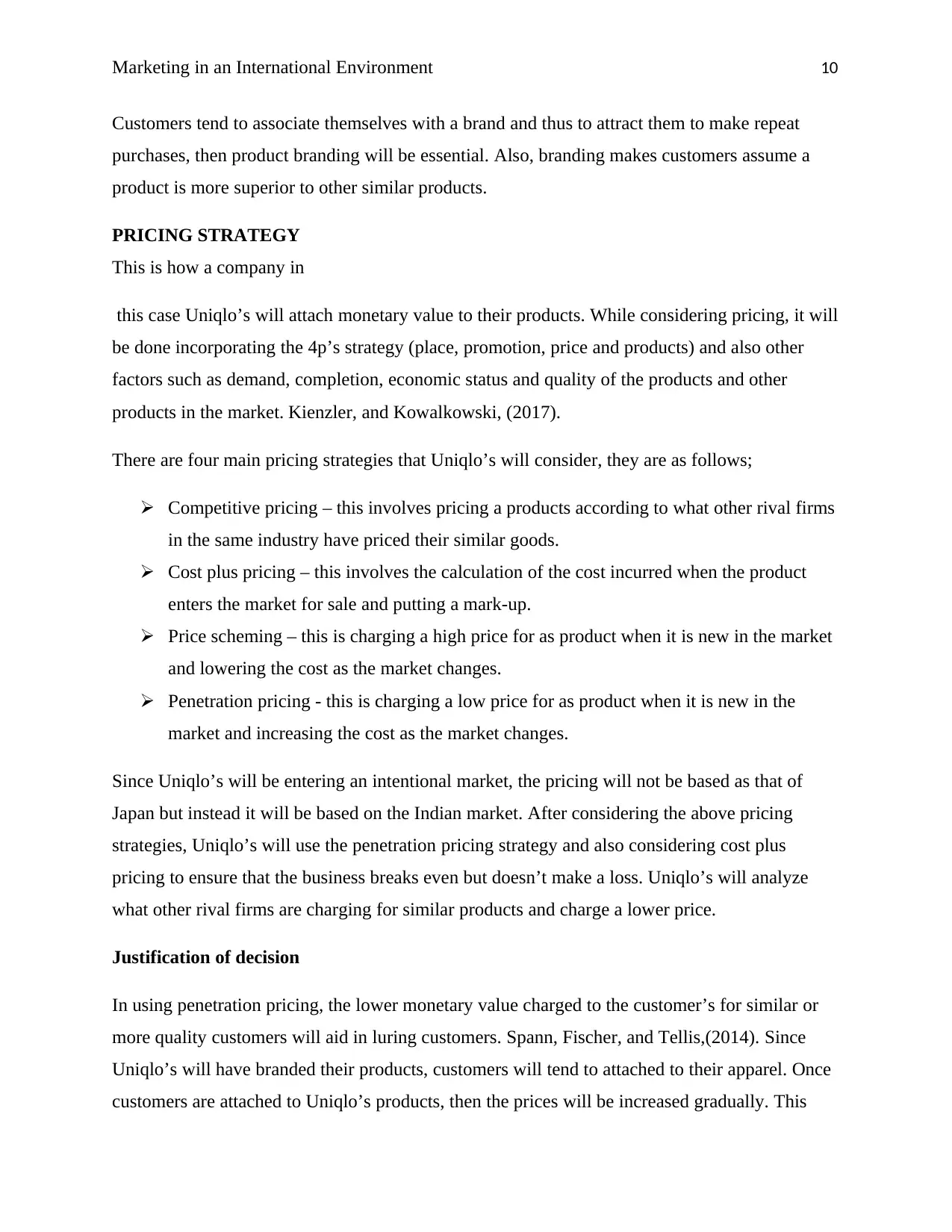
Marketing in an International Environment 10
Customers tend to associate themselves with a brand and thus to attract them to make repeat
purchases, then product branding will be essential. Also, branding makes customers assume a
product is more superior to other similar products.
PRICING STRATEGY
This is how a company in
this case Uniqlo’s will attach monetary value to their products. While considering pricing, it will
be done incorporating the 4p’s strategy (place, promotion, price and products) and also other
factors such as demand, completion, economic status and quality of the products and other
products in the market. Kienzler, and Kowalkowski, (2017).
There are four main pricing strategies that Uniqlo’s will consider, they are as follows;
Competitive pricing – this involves pricing a products according to what other rival firms
in the same industry have priced their similar goods.
Cost plus pricing – this involves the calculation of the cost incurred when the product
enters the market for sale and putting a mark-up.
Price scheming – this is charging a high price for as product when it is new in the market
and lowering the cost as the market changes.
Penetration pricing - this is charging a low price for as product when it is new in the
market and increasing the cost as the market changes.
Since Uniqlo’s will be entering an intentional market, the pricing will not be based as that of
Japan but instead it will be based on the Indian market. After considering the above pricing
strategies, Uniqlo’s will use the penetration pricing strategy and also considering cost plus
pricing to ensure that the business breaks even but doesn’t make a loss. Uniqlo’s will analyze
what other rival firms are charging for similar products and charge a lower price.
Justification of decision
In using penetration pricing, the lower monetary value charged to the customer’s for similar or
more quality customers will aid in luring customers. Spann, Fischer, and Tellis,(2014). Since
Uniqlo’s will have branded their products, customers will tend to attached to their apparel. Once
customers are attached to Uniqlo’s products, then the prices will be increased gradually. This
Customers tend to associate themselves with a brand and thus to attract them to make repeat
purchases, then product branding will be essential. Also, branding makes customers assume a
product is more superior to other similar products.
PRICING STRATEGY
This is how a company in
this case Uniqlo’s will attach monetary value to their products. While considering pricing, it will
be done incorporating the 4p’s strategy (place, promotion, price and products) and also other
factors such as demand, completion, economic status and quality of the products and other
products in the market. Kienzler, and Kowalkowski, (2017).
There are four main pricing strategies that Uniqlo’s will consider, they are as follows;
Competitive pricing – this involves pricing a products according to what other rival firms
in the same industry have priced their similar goods.
Cost plus pricing – this involves the calculation of the cost incurred when the product
enters the market for sale and putting a mark-up.
Price scheming – this is charging a high price for as product when it is new in the market
and lowering the cost as the market changes.
Penetration pricing - this is charging a low price for as product when it is new in the
market and increasing the cost as the market changes.
Since Uniqlo’s will be entering an intentional market, the pricing will not be based as that of
Japan but instead it will be based on the Indian market. After considering the above pricing
strategies, Uniqlo’s will use the penetration pricing strategy and also considering cost plus
pricing to ensure that the business breaks even but doesn’t make a loss. Uniqlo’s will analyze
what other rival firms are charging for similar products and charge a lower price.
Justification of decision
In using penetration pricing, the lower monetary value charged to the customer’s for similar or
more quality customers will aid in luring customers. Spann, Fischer, and Tellis,(2014). Since
Uniqlo’s will have branded their products, customers will tend to attached to their apparel. Once
customers are attached to Uniqlo’s products, then the prices will be increased gradually. This
Secure Best Marks with AI Grader
Need help grading? Try our AI Grader for instant feedback on your assignments.
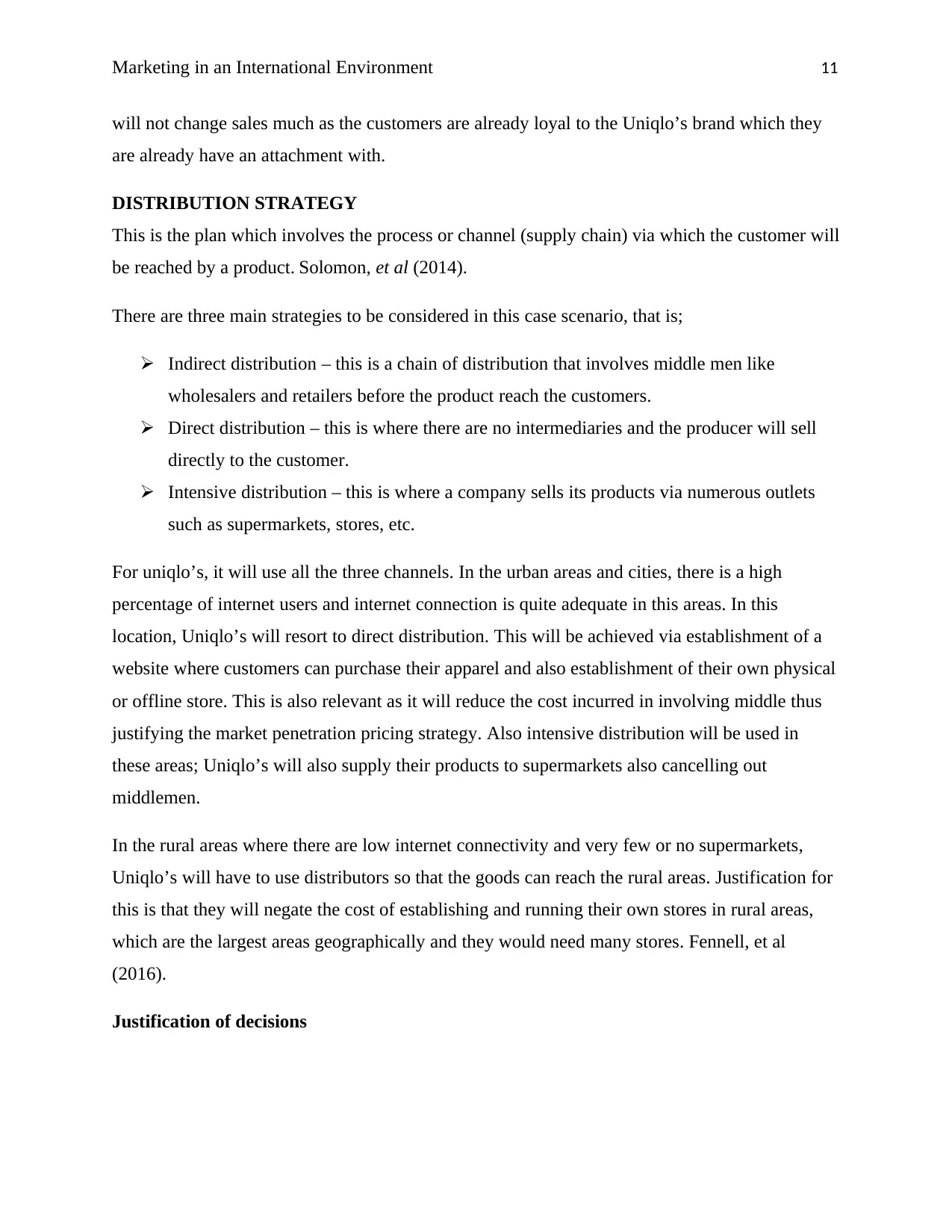
Marketing in an International Environment 11
will not change sales much as the customers are already loyal to the Uniqlo’s brand which they
are already have an attachment with.
DISTRIBUTION STRATEGY
This is the plan which involves the process or channel (supply chain) via which the customer will
be reached by a product. Solomon, et al (2014).
There are three main strategies to be considered in this case scenario, that is;
Indirect distribution – this is a chain of distribution that involves middle men like
wholesalers and retailers before the product reach the customers.
Direct distribution – this is where there are no intermediaries and the producer will sell
directly to the customer.
Intensive distribution – this is where a company sells its products via numerous outlets
such as supermarkets, stores, etc.
For uniqlo’s, it will use all the three channels. In the urban areas and cities, there is a high
percentage of internet users and internet connection is quite adequate in this areas. In this
location, Uniqlo’s will resort to direct distribution. This will be achieved via establishment of a
website where customers can purchase their apparel and also establishment of their own physical
or offline store. This is also relevant as it will reduce the cost incurred in involving middle thus
justifying the market penetration pricing strategy. Also intensive distribution will be used in
these areas; Uniqlo’s will also supply their products to supermarkets also cancelling out
middlemen.
In the rural areas where there are low internet connectivity and very few or no supermarkets,
Uniqlo’s will have to use distributors so that the goods can reach the rural areas. Justification for
this is that they will negate the cost of establishing and running their own stores in rural areas,
which are the largest areas geographically and they would need many stores. Fennell, et al
(2016).
Justification of decisions
will not change sales much as the customers are already loyal to the Uniqlo’s brand which they
are already have an attachment with.
DISTRIBUTION STRATEGY
This is the plan which involves the process or channel (supply chain) via which the customer will
be reached by a product. Solomon, et al (2014).
There are three main strategies to be considered in this case scenario, that is;
Indirect distribution – this is a chain of distribution that involves middle men like
wholesalers and retailers before the product reach the customers.
Direct distribution – this is where there are no intermediaries and the producer will sell
directly to the customer.
Intensive distribution – this is where a company sells its products via numerous outlets
such as supermarkets, stores, etc.
For uniqlo’s, it will use all the three channels. In the urban areas and cities, there is a high
percentage of internet users and internet connection is quite adequate in this areas. In this
location, Uniqlo’s will resort to direct distribution. This will be achieved via establishment of a
website where customers can purchase their apparel and also establishment of their own physical
or offline store. This is also relevant as it will reduce the cost incurred in involving middle thus
justifying the market penetration pricing strategy. Also intensive distribution will be used in
these areas; Uniqlo’s will also supply their products to supermarkets also cancelling out
middlemen.
In the rural areas where there are low internet connectivity and very few or no supermarkets,
Uniqlo’s will have to use distributors so that the goods can reach the rural areas. Justification for
this is that they will negate the cost of establishing and running their own stores in rural areas,
which are the largest areas geographically and they would need many stores. Fennell, et al
(2016).
Justification of decisions
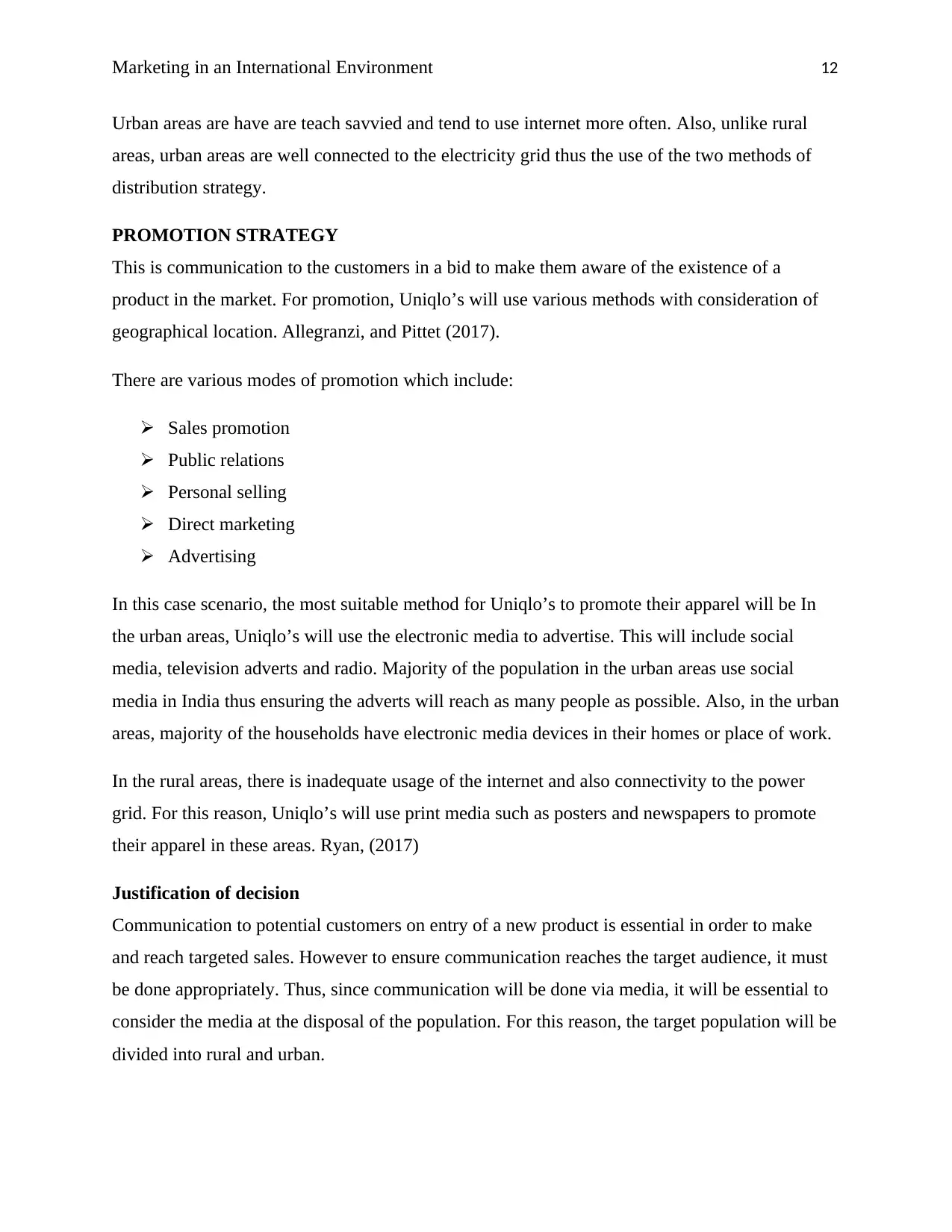
Marketing in an International Environment 12
Urban areas are have are teach savvied and tend to use internet more often. Also, unlike rural
areas, urban areas are well connected to the electricity grid thus the use of the two methods of
distribution strategy.
PROMOTION STRATEGY
This is communication to the customers in a bid to make them aware of the existence of a
product in the market. For promotion, Uniqlo’s will use various methods with consideration of
geographical location. Allegranzi, and Pittet (2017).
There are various modes of promotion which include:
Sales promotion
Public relations
Personal selling
Direct marketing
Advertising
In this case scenario, the most suitable method for Uniqlo’s to promote their apparel will be In
the urban areas, Uniqlo’s will use the electronic media to advertise. This will include social
media, television adverts and radio. Majority of the population in the urban areas use social
media in India thus ensuring the adverts will reach as many people as possible. Also, in the urban
areas, majority of the households have electronic media devices in their homes or place of work.
In the rural areas, there is inadequate usage of the internet and also connectivity to the power
grid. For this reason, Uniqlo’s will use print media such as posters and newspapers to promote
their apparel in these areas. Ryan, (2017)
Justification of decision
Communication to potential customers on entry of a new product is essential in order to make
and reach targeted sales. However to ensure communication reaches the target audience, it must
be done appropriately. Thus, since communication will be done via media, it will be essential to
consider the media at the disposal of the population. For this reason, the target population will be
divided into rural and urban.
Urban areas are have are teach savvied and tend to use internet more often. Also, unlike rural
areas, urban areas are well connected to the electricity grid thus the use of the two methods of
distribution strategy.
PROMOTION STRATEGY
This is communication to the customers in a bid to make them aware of the existence of a
product in the market. For promotion, Uniqlo’s will use various methods with consideration of
geographical location. Allegranzi, and Pittet (2017).
There are various modes of promotion which include:
Sales promotion
Public relations
Personal selling
Direct marketing
Advertising
In this case scenario, the most suitable method for Uniqlo’s to promote their apparel will be In
the urban areas, Uniqlo’s will use the electronic media to advertise. This will include social
media, television adverts and radio. Majority of the population in the urban areas use social
media in India thus ensuring the adverts will reach as many people as possible. Also, in the urban
areas, majority of the households have electronic media devices in their homes or place of work.
In the rural areas, there is inadequate usage of the internet and also connectivity to the power
grid. For this reason, Uniqlo’s will use print media such as posters and newspapers to promote
their apparel in these areas. Ryan, (2017)
Justification of decision
Communication to potential customers on entry of a new product is essential in order to make
and reach targeted sales. However to ensure communication reaches the target audience, it must
be done appropriately. Thus, since communication will be done via media, it will be essential to
consider the media at the disposal of the population. For this reason, the target population will be
divided into rural and urban.
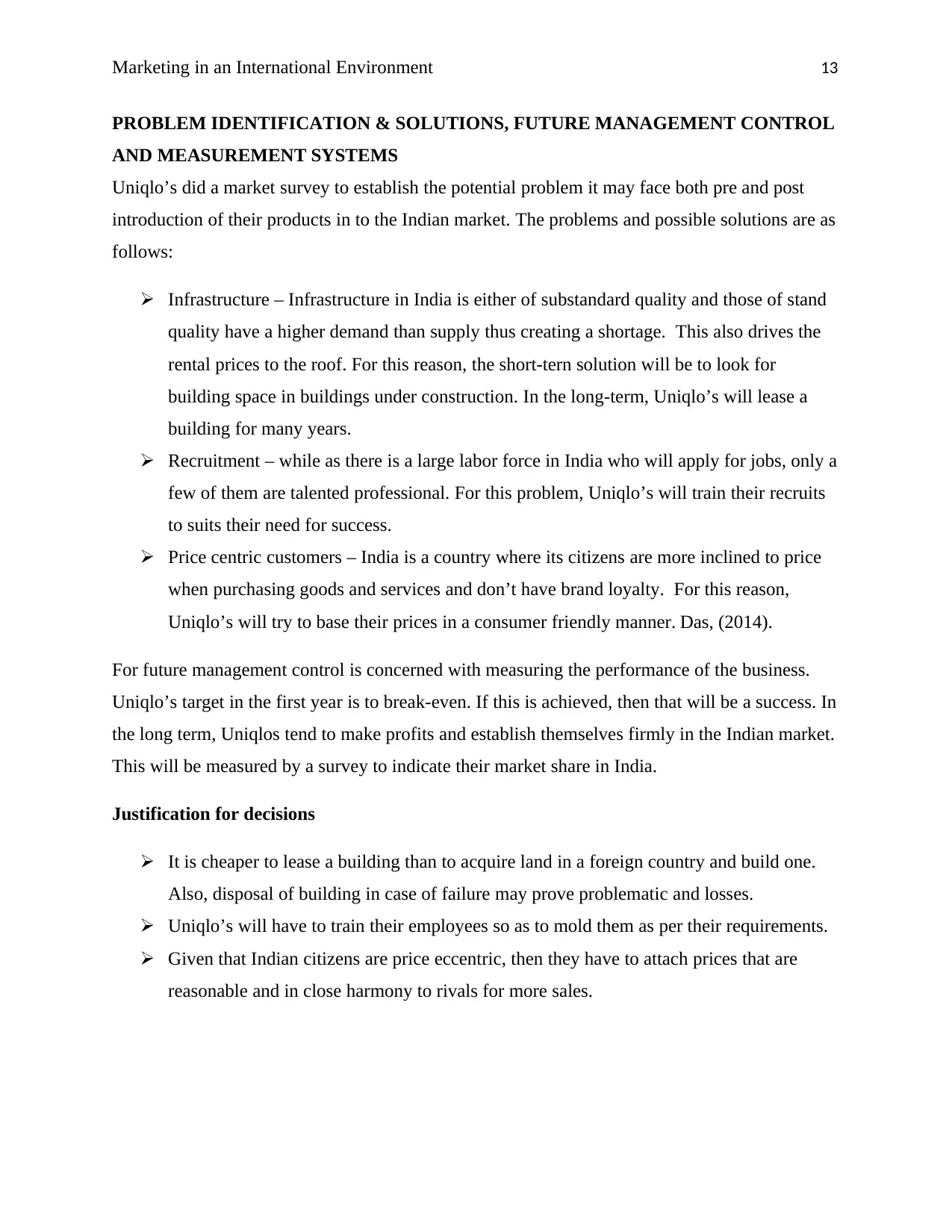
Marketing in an International Environment 13
PROBLEM IDENTIFICATION & SOLUTIONS, FUTURE MANAGEMENT CONTROL
AND MEASUREMENT SYSTEMS
Uniqlo’s did a market survey to establish the potential problem it may face both pre and post
introduction of their products in to the Indian market. The problems and possible solutions are as
follows:
Infrastructure – Infrastructure in India is either of substandard quality and those of stand
quality have a higher demand than supply thus creating a shortage. This also drives the
rental prices to the roof. For this reason, the short-tern solution will be to look for
building space in buildings under construction. In the long-term, Uniqlo’s will lease a
building for many years.
Recruitment – while as there is a large labor force in India who will apply for jobs, only a
few of them are talented professional. For this problem, Uniqlo’s will train their recruits
to suits their need for success.
Price centric customers – India is a country where its citizens are more inclined to price
when purchasing goods and services and don’t have brand loyalty. For this reason,
Uniqlo’s will try to base their prices in a consumer friendly manner. Das, (2014).
For future management control is concerned with measuring the performance of the business.
Uniqlo’s target in the first year is to break-even. If this is achieved, then that will be a success. In
the long term, Uniqlos tend to make profits and establish themselves firmly in the Indian market.
This will be measured by a survey to indicate their market share in India.
Justification for decisions
It is cheaper to lease a building than to acquire land in a foreign country and build one.
Also, disposal of building in case of failure may prove problematic and losses.
Uniqlo’s will have to train their employees so as to mold them as per their requirements.
Given that Indian citizens are price eccentric, then they have to attach prices that are
reasonable and in close harmony to rivals for more sales.
PROBLEM IDENTIFICATION & SOLUTIONS, FUTURE MANAGEMENT CONTROL
AND MEASUREMENT SYSTEMS
Uniqlo’s did a market survey to establish the potential problem it may face both pre and post
introduction of their products in to the Indian market. The problems and possible solutions are as
follows:
Infrastructure – Infrastructure in India is either of substandard quality and those of stand
quality have a higher demand than supply thus creating a shortage. This also drives the
rental prices to the roof. For this reason, the short-tern solution will be to look for
building space in buildings under construction. In the long-term, Uniqlo’s will lease a
building for many years.
Recruitment – while as there is a large labor force in India who will apply for jobs, only a
few of them are talented professional. For this problem, Uniqlo’s will train their recruits
to suits their need for success.
Price centric customers – India is a country where its citizens are more inclined to price
when purchasing goods and services and don’t have brand loyalty. For this reason,
Uniqlo’s will try to base their prices in a consumer friendly manner. Das, (2014).
For future management control is concerned with measuring the performance of the business.
Uniqlo’s target in the first year is to break-even. If this is achieved, then that will be a success. In
the long term, Uniqlos tend to make profits and establish themselves firmly in the Indian market.
This will be measured by a survey to indicate their market share in India.
Justification for decisions
It is cheaper to lease a building than to acquire land in a foreign country and build one.
Also, disposal of building in case of failure may prove problematic and losses.
Uniqlo’s will have to train their employees so as to mold them as per their requirements.
Given that Indian citizens are price eccentric, then they have to attach prices that are
reasonable and in close harmony to rivals for more sales.
Paraphrase This Document
Need a fresh take? Get an instant paraphrase of this document with our AI Paraphraser
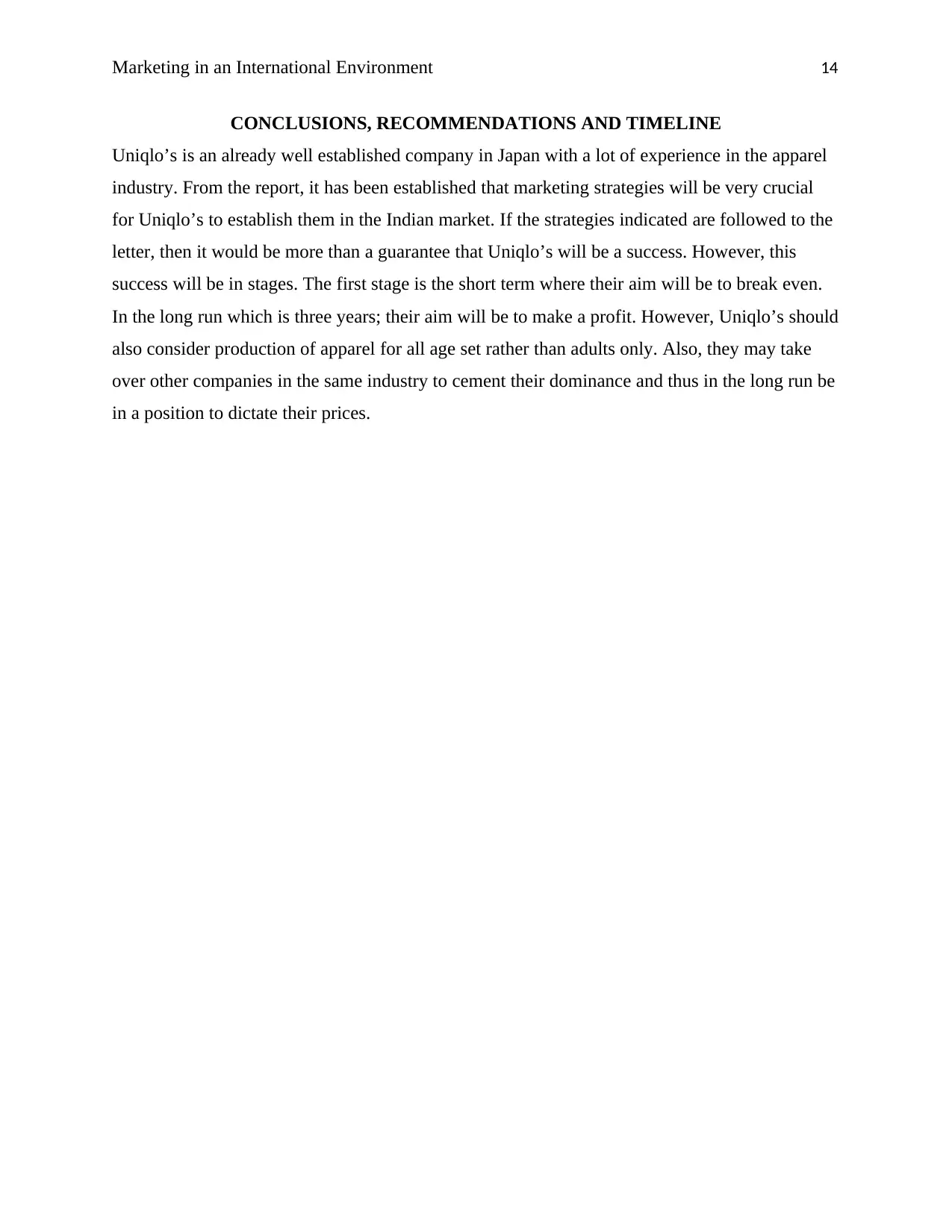
Marketing in an International Environment 14
CONCLUSIONS, RECOMMENDATIONS AND TIMELINE
Uniqlo’s is an already well established company in Japan with a lot of experience in the apparel
industry. From the report, it has been established that marketing strategies will be very crucial
for Uniqlo’s to establish them in the Indian market. If the strategies indicated are followed to the
letter, then it would be more than a guarantee that Uniqlo’s will be a success. However, this
success will be in stages. The first stage is the short term where their aim will be to break even.
In the long run which is three years; their aim will be to make a profit. However, Uniqlo’s should
also consider production of apparel for all age set rather than adults only. Also, they may take
over other companies in the same industry to cement their dominance and thus in the long run be
in a position to dictate their prices.
CONCLUSIONS, RECOMMENDATIONS AND TIMELINE
Uniqlo’s is an already well established company in Japan with a lot of experience in the apparel
industry. From the report, it has been established that marketing strategies will be very crucial
for Uniqlo’s to establish them in the Indian market. If the strategies indicated are followed to the
letter, then it would be more than a guarantee that Uniqlo’s will be a success. However, this
success will be in stages. The first stage is the short term where their aim will be to break even.
In the long run which is three years; their aim will be to make a profit. However, Uniqlo’s should
also consider production of apparel for all age set rather than adults only. Also, they may take
over other companies in the same industry to cement their dominance and thus in the long run be
in a position to dictate their prices.
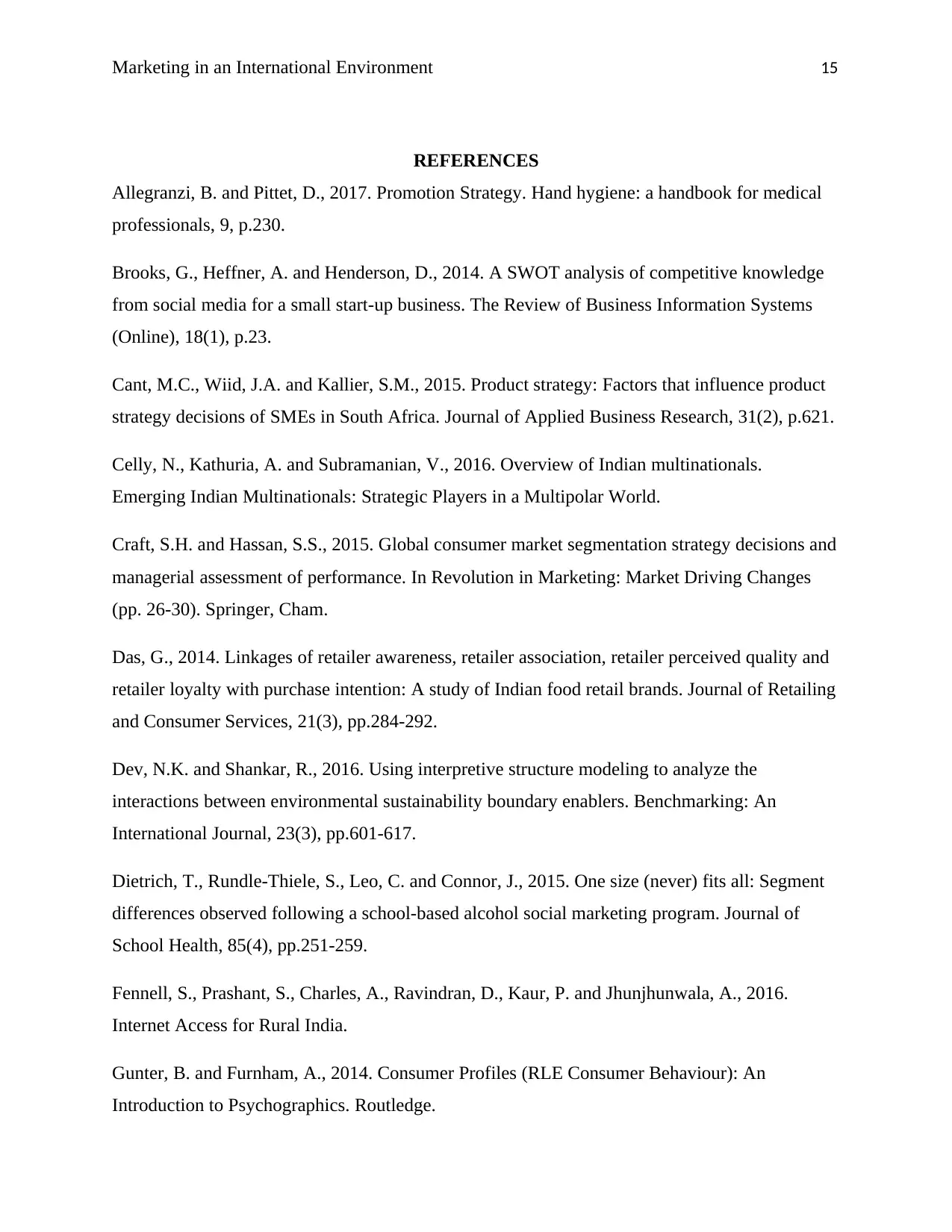
Marketing in an International Environment 15
REFERENCES
Allegranzi, B. and Pittet, D., 2017. Promotion Strategy. Hand hygiene: a handbook for medical
professionals, 9, p.230.
Brooks, G., Heffner, A. and Henderson, D., 2014. A SWOT analysis of competitive knowledge
from social media for a small start-up business. The Review of Business Information Systems
(Online), 18(1), p.23.
Cant, M.C., Wiid, J.A. and Kallier, S.M., 2015. Product strategy: Factors that influence product
strategy decisions of SMEs in South Africa. Journal of Applied Business Research, 31(2), p.621.
Celly, N., Kathuria, A. and Subramanian, V., 2016. Overview of Indian multinationals.
Emerging Indian Multinationals: Strategic Players in a Multipolar World.
Craft, S.H. and Hassan, S.S., 2015. Global consumer market segmentation strategy decisions and
managerial assessment of performance. In Revolution in Marketing: Market Driving Changes
(pp. 26-30). Springer, Cham.
Das, G., 2014. Linkages of retailer awareness, retailer association, retailer perceived quality and
retailer loyalty with purchase intention: A study of Indian food retail brands. Journal of Retailing
and Consumer Services, 21(3), pp.284-292.
Dev, N.K. and Shankar, R., 2016. Using interpretive structure modeling to analyze the
interactions between environmental sustainability boundary enablers. Benchmarking: An
International Journal, 23(3), pp.601-617.
Dietrich, T., Rundle‐Thiele, S., Leo, C. and Connor, J., 2015. One size (never) fits all: Segment
differences observed following a school‐based alcohol social marketing program. Journal of
School Health, 85(4), pp.251-259.
Fennell, S., Prashant, S., Charles, A., Ravindran, D., Kaur, P. and Jhunjhunwala, A., 2016.
Internet Access for Rural India.
Gunter, B. and Furnham, A., 2014. Consumer Profiles (RLE Consumer Behaviour): An
Introduction to Psychographics. Routledge.
REFERENCES
Allegranzi, B. and Pittet, D., 2017. Promotion Strategy. Hand hygiene: a handbook for medical
professionals, 9, p.230.
Brooks, G., Heffner, A. and Henderson, D., 2014. A SWOT analysis of competitive knowledge
from social media for a small start-up business. The Review of Business Information Systems
(Online), 18(1), p.23.
Cant, M.C., Wiid, J.A. and Kallier, S.M., 2015. Product strategy: Factors that influence product
strategy decisions of SMEs in South Africa. Journal of Applied Business Research, 31(2), p.621.
Celly, N., Kathuria, A. and Subramanian, V., 2016. Overview of Indian multinationals.
Emerging Indian Multinationals: Strategic Players in a Multipolar World.
Craft, S.H. and Hassan, S.S., 2015. Global consumer market segmentation strategy decisions and
managerial assessment of performance. In Revolution in Marketing: Market Driving Changes
(pp. 26-30). Springer, Cham.
Das, G., 2014. Linkages of retailer awareness, retailer association, retailer perceived quality and
retailer loyalty with purchase intention: A study of Indian food retail brands. Journal of Retailing
and Consumer Services, 21(3), pp.284-292.
Dev, N.K. and Shankar, R., 2016. Using interpretive structure modeling to analyze the
interactions between environmental sustainability boundary enablers. Benchmarking: An
International Journal, 23(3), pp.601-617.
Dietrich, T., Rundle‐Thiele, S., Leo, C. and Connor, J., 2015. One size (never) fits all: Segment
differences observed following a school‐based alcohol social marketing program. Journal of
School Health, 85(4), pp.251-259.
Fennell, S., Prashant, S., Charles, A., Ravindran, D., Kaur, P. and Jhunjhunwala, A., 2016.
Internet Access for Rural India.
Gunter, B. and Furnham, A., 2014. Consumer Profiles (RLE Consumer Behaviour): An
Introduction to Psychographics. Routledge.
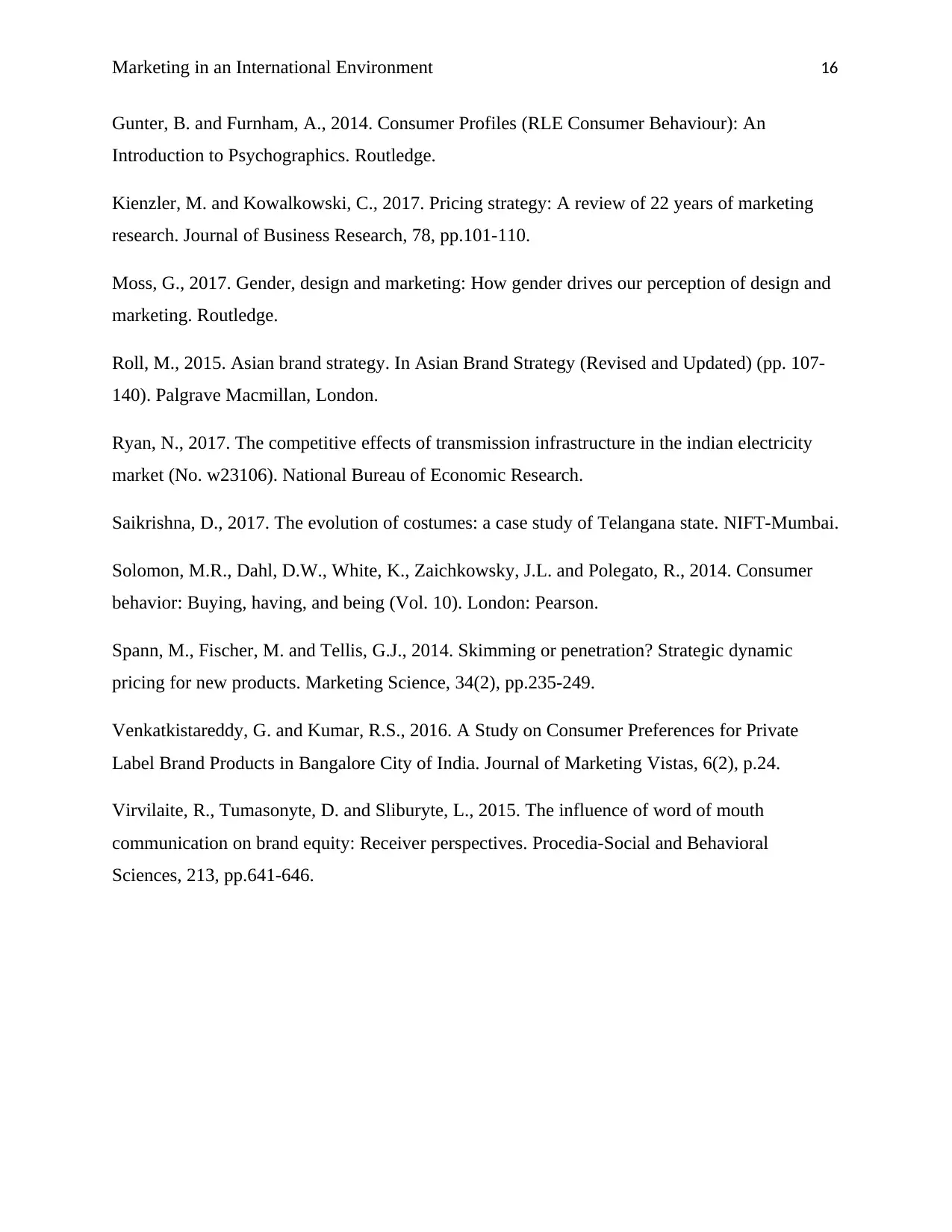
Marketing in an International Environment 16
Gunter, B. and Furnham, A., 2014. Consumer Profiles (RLE Consumer Behaviour): An
Introduction to Psychographics. Routledge.
Kienzler, M. and Kowalkowski, C., 2017. Pricing strategy: A review of 22 years of marketing
research. Journal of Business Research, 78, pp.101-110.
Moss, G., 2017. Gender, design and marketing: How gender drives our perception of design and
marketing. Routledge.
Roll, M., 2015. Asian brand strategy. In Asian Brand Strategy (Revised and Updated) (pp. 107-
140). Palgrave Macmillan, London.
Ryan, N., 2017. The competitive effects of transmission infrastructure in the indian electricity
market (No. w23106). National Bureau of Economic Research.
Saikrishna, D., 2017. The evolution of costumes: a case study of Telangana state. NIFT-Mumbai.
Solomon, M.R., Dahl, D.W., White, K., Zaichkowsky, J.L. and Polegato, R., 2014. Consumer
behavior: Buying, having, and being (Vol. 10). London: Pearson.
Spann, M., Fischer, M. and Tellis, G.J., 2014. Skimming or penetration? Strategic dynamic
pricing for new products. Marketing Science, 34(2), pp.235-249.
Venkatkistareddy, G. and Kumar, R.S., 2016. A Study on Consumer Preferences for Private
Label Brand Products in Bangalore City of India. Journal of Marketing Vistas, 6(2), p.24.
Virvilaite, R., Tumasonyte, D. and Sliburyte, L., 2015. The influence of word of mouth
communication on brand equity: Receiver perspectives. Procedia-Social and Behavioral
Sciences, 213, pp.641-646.
Gunter, B. and Furnham, A., 2014. Consumer Profiles (RLE Consumer Behaviour): An
Introduction to Psychographics. Routledge.
Kienzler, M. and Kowalkowski, C., 2017. Pricing strategy: A review of 22 years of marketing
research. Journal of Business Research, 78, pp.101-110.
Moss, G., 2017. Gender, design and marketing: How gender drives our perception of design and
marketing. Routledge.
Roll, M., 2015. Asian brand strategy. In Asian Brand Strategy (Revised and Updated) (pp. 107-
140). Palgrave Macmillan, London.
Ryan, N., 2017. The competitive effects of transmission infrastructure in the indian electricity
market (No. w23106). National Bureau of Economic Research.
Saikrishna, D., 2017. The evolution of costumes: a case study of Telangana state. NIFT-Mumbai.
Solomon, M.R., Dahl, D.W., White, K., Zaichkowsky, J.L. and Polegato, R., 2014. Consumer
behavior: Buying, having, and being (Vol. 10). London: Pearson.
Spann, M., Fischer, M. and Tellis, G.J., 2014. Skimming or penetration? Strategic dynamic
pricing for new products. Marketing Science, 34(2), pp.235-249.
Venkatkistareddy, G. and Kumar, R.S., 2016. A Study on Consumer Preferences for Private
Label Brand Products in Bangalore City of India. Journal of Marketing Vistas, 6(2), p.24.
Virvilaite, R., Tumasonyte, D. and Sliburyte, L., 2015. The influence of word of mouth
communication on brand equity: Receiver perspectives. Procedia-Social and Behavioral
Sciences, 213, pp.641-646.
Secure Best Marks with AI Grader
Need help grading? Try our AI Grader for instant feedback on your assignments.
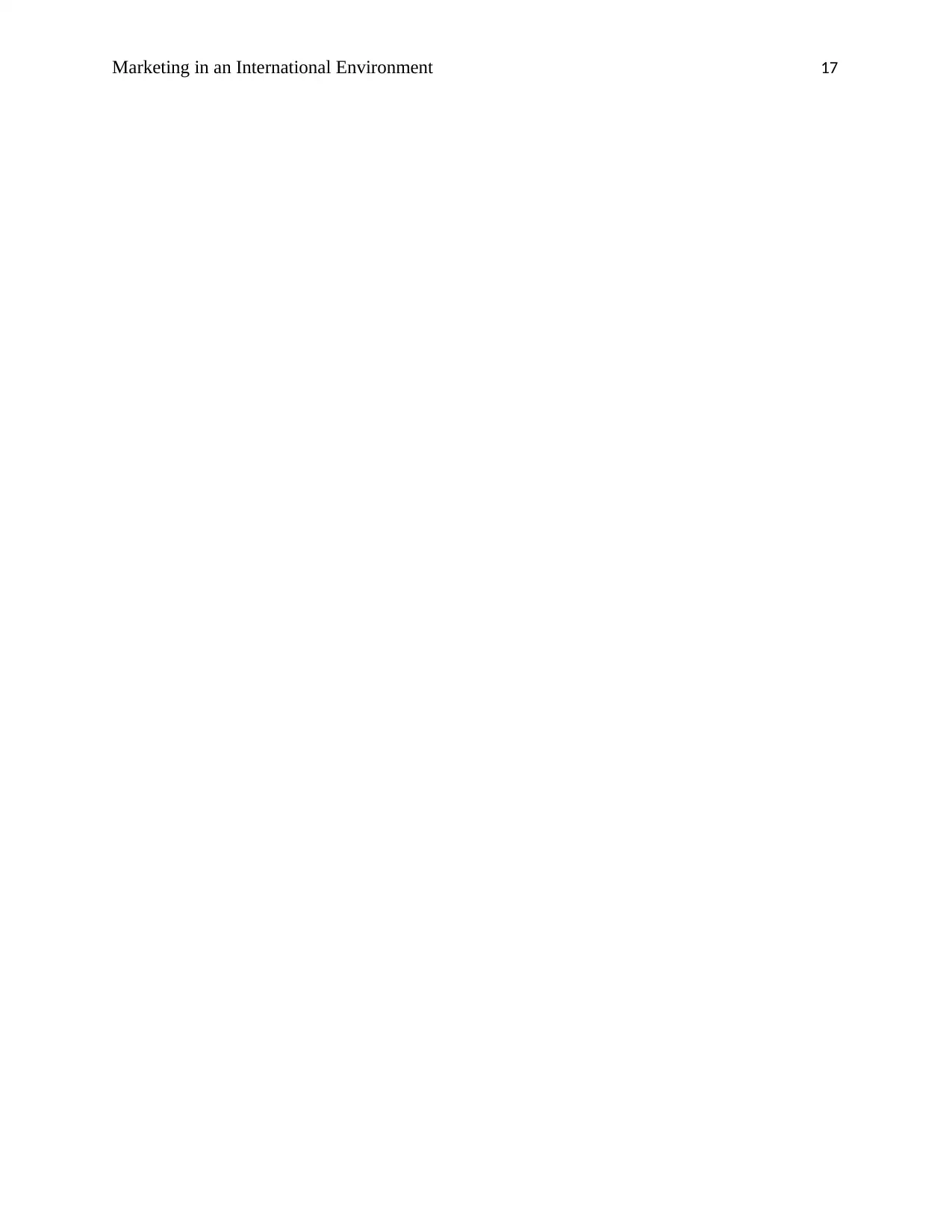
Marketing in an International Environment 17
1 out of 17
Related Documents
Your All-in-One AI-Powered Toolkit for Academic Success.
+13062052269
info@desklib.com
Available 24*7 on WhatsApp / Email
![[object Object]](/_next/static/media/star-bottom.7253800d.svg)
Unlock your academic potential
© 2024 | Zucol Services PVT LTD | All rights reserved.




